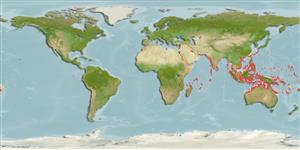Common names from other countries
>
Gobiiformes (Gobies) >
Gobiidae (Gobies) > Gobiinae
Etymology: Trimma: Greek, trimma, -atos = something crushed (Ref. 45335).
More on author: Smith.
Environment: milieu / climate zone / depth range / distribution range
Ökologie
seewasser riff-verbunden; tiefenbereich 3 - 30 m (Ref. 1602), usually 3 - 30 m (Ref. 27115). Tropical; 22°C - 26°C (Ref. 27115); 30°N - 22°S
Indo-West Pacific: Seychelles, Aldabra, Chagos Islands, Ryukyu Islands, and Loyalty Islands; Mariana and Marshall islands in Micronesia.
Size / Gewicht / Alter
Maturity: Lm ? range ? - ? cm
Max length : 3.5 cm SL Männchen/unbestimmt; (Ref. 48637)
Rückenflossenstacheln (insgesamt): 7; Rückenflossenweichstrahlen (insgesamt): 7-8; Afterflossenstacheln 1; Afterflossenweichstrahlen: 7 - 9. Diagnosis: a frontal ridge behind the orbits that slopes steeply into a wide interorbital trench
anteromedially, and into postorbital trenches laterally; posterior nasal opening separate from eye; second spine of first dorsal fin elongate, third spine occasionally elongate; fifth pelvic fin ray branched once dichotomously; body color orange-red with seven dorsolateral white spots
between posterodorsal margin of the peduncle and origin of first dorsal, and with four ventrolateral spots between posteroventral margin of peduncle and origin of last anal ray; facial pattern uniform dusky orange-grey colour under orbit, with an orange vertical blotch, edged in melanophores on vertical limb of the preopercle resembling a club; conspicuous bar of melanophores extending vertically across posterior margin of pectoral base (Ref. 57688).
Occurs in lagoons and seaward reefs; on rubble and reef rock (Ref. 1602); also over coral patches interspaced with fine sandy bottoms, occasionally form small schools (Ref. 37688). Feeds on copepods, ostracods, and radiolarians (Ref. 1602).
Life cycle and mating behavior
Geschlechtsreife | Fortpflanzung | Ablaichen | Eier | Fecundity | Larven
Myers, R.F., 1991. Micronesian reef fishes. Second Ed. Coral Graphics, Barrigada, Guam. 298 p. (Ref. 1602)
IUCN Rote Liste Status (Ref. 130435)
CITES (Ref. 128078)
Not Evaluated
Bedrohung für Menschen
Harmless
Nutzung durch Menschen
Aquarium: Kommerziell
Mehr Information
NamenSynonymeMetabolismusRäuberÖkotoxikologieFortpflanzungGeschlechtsreifeAblaichenFecundityEierEientwicklung
ReferenzenAquakulturAquakultur ProfilZuchtlinienGenetikElectrophoresesVererbbarkeitKrankheitenVerarbeitungMass conversion
PartnerBilderStamps, Coins Misc.LauteCiguateraGeschwindigkeitSchwimmstilKiemenoberflächeOtolithsGehirngrößeSehfähigkeit
Tools
Zusatzinformationen
Download XML
Internet Quellen
Estimates based on models
Preferred temperature (Ref.
115969): 25.3 - 29, mean 28 (based on 1090 cells).
Phylogenetic diversity index (Ref.
82804): PD
50 = 0.5000 [Uniqueness, from 0.5 = low to 2.0 = high].
Bayesian length-weight: a=0.01023 (0.00477 - 0.02194), b=3.02 (2.84 - 3.20), in cm Total Length, based on LWR estimates for this (Sub)family-body shape (Ref.
93245).
Trophic level (Ref.
69278): 3.3 ±0.42 se; based on food items.
Widerstandsfähigkeit (Ref.
120179): hoch, Verdopplung der Population dauert weniger als 15 Monate. (Preliminary K or Fecundity.).
Fishing Vulnerability (Ref.
59153): Low vulnerability (10 of 100).
